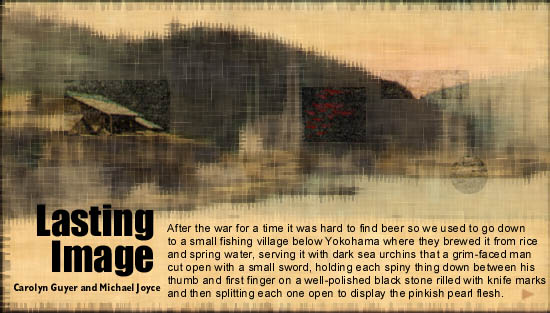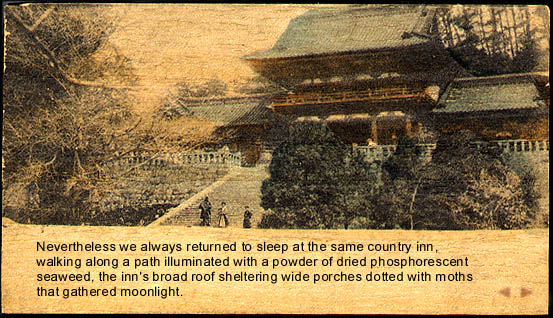
I’m going to analyse the hypertext “Lasting Image” created by Michael Joyce and Carolyn Guyer. I chose it because I thought it would be interesting to read about the bomb in Yokohama since I saw the first page of “Lasting Image” and it talked about it.
I will divide this part of the work into six different aspects:
This kind of literature is new for me. I had never read it before, although it is a good way to read. Currently, many people can access this kind of literature but actually there are not too readers. I think if people tried it, they would read them frequently. We can compare it with the traditional literature which is reading a book calmly and leave it whenever you want. The difference is big because to read the hypertextual literature you must have the internet at home, and they are difficult to find.
2. Physical structure of the hypertext
The authors of the hypertext I have selected are Carolyn Guyer and Michael Joyce. It is based on some original pictures from Japan. There are ten in all and they are interrelated in a story that the reader can read it anyway because the text is composed as a webpage. Therefore, the story is composed of both words and images.
We will realize that to read this hypertext you need to click on the little arrows in order to take us to the following webpage. We can check it gazing at this image:

(http://www.eastgate.com/LastingImage/)
Another way of reading “Lasting Image” is the one that you have to click on certain places inside the photos and in certain words of the text, but this is not a recommended way of reading the story because you can not have any control over where it takes you. This picture is a good example to check it:

(http://www.eastgate.com/LastingImage/countryinn2.html)
On it we can see that there are geometric figures like circles, squares, rectangles. These are the places you have to click on to go to another photo.
I think the narrator is a soldier in Japan just after World War II. He is travelling with his friends to a small fishing village below Yokohama. There, there is a blind man who wears a wooden camera with which he takes a lot of photos. The narrator and his friends are told that this blind man lost his sight looking up into the searing light at Nagasaki. Some nights they drink Saki in the fishermen’s huts but they return to sleep at their country inn. One of the men, finds the blind’s photographs and uses them as a deck of playing cards, gambling with cards using them to decide the assignment of duties within the camp.
Firstly, I must say that the own narrator is in the story. He is the one who tells us this story, who describes the images, the characters, the places we are, and so on.
Now, I am going to explain some features of the characters. There are not many characters and information about them but I can imagine how they are because of what they think, say or do.
The main character in the story is Meisetsu, the blind man who is a Buddhist monk cause he lives in a Buddhist temple. The narrator does not tell any else about him but I suppose, like all monks, he will be pacific, calm, respectful, understanding, nice person. He is blind because he was looking up into the searing light at Nagasaki, when the bomb exploited. Meisetsu is always wearing a wooden camera around his neck because he is a lover of photography.
There are other characters which are not described. They are for example, the grim-faced man from this village below Yokohama who serves the dark sea urchins with beer.
The narrator also mentions the fishermen in the seventh picture (if we follow a chronological order). We know they drink bear in their huts and smoke with pipe.
In the picture 9, it appears a new character, the Dutchman, who is a friend of the narrator. He stacks the blind monk’s photos into a deck like pasteboards.
In the last picture, the narrator mentions a Geisha who sings in a room with the perfumed tatami. Everyone wants to sleeps in this room. She is one of the “things” they are gambling with the cards.
The language used by Michael Joyce and Carolyn Guyer is standard, I think, because in my case I have looked up few words in the dictionary. These are examples of the vocabulary I’ve looked up: sea urchins, splitting, moths, crimson, etc.
A big curiosity I have seen is the two last words: they are the same as the title but inverted. I don’t know if it has any special meaning. The space is not described anyway with any specific kind of language as it could be described in other stories: “small fishing village below Yokohama”, “Meisetsu had los his sight looking up into the searing light at Nagasaki”, etc.
The description of the characters is not so detailed, but the narrator almost doesn’t describe them.
The text is neither poetry nor theatre. It is narrative because there are not dialogs.
I personally think the author gets that the reader can convert in the main character thanks to a good language since the reader understands it in a good way, not in a perfect way because, as I have said, there are many words that you must look them up in a dictionary.
The fact that the author uses verbs with the first person of plural is because he is included in the story.
6. Main Sources
http://faculty.vassar.edu/mijoyce/htexts2.html
http://en.wikipedia.org/wiki/Michael_Joyce
http://www.eastgate.com/people/Joyce.html
http://www.eastgate.com/people/Guyer.html
http://www.mothermillennia.org/Carolyn/CGuyer_Bio.html
http://en.wikipedia.org/wiki/Nagasaki
http://en.wikipedia.org/wiki/Hypertext_fiction
http://en.wikipedia.org/wiki/Fujiyama
Page last modified: 4th of December
Academic year 2008/2009
© a.r.e.a./Dr.Vicente Forés López
© Fran García Ribes
garifra2@alumni.uv.es
Universitat de Valčncia Press